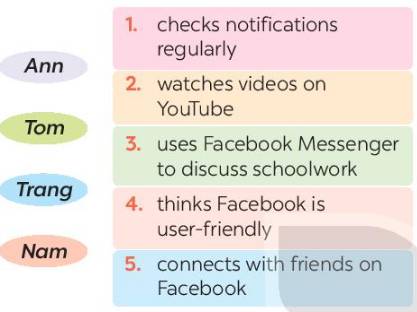1.it/for/is/perents/necessary/to/their/teach/children/use/to/social/how/reasonably/media
A. It is necessary to parents for teach their children how to use social media reasonably
B. It is necessary for parents to teach their children how use social media reasonably
C. It is necessary to teach their children for parents how to use social media reasonably
D. It is necessary for parents how to use social media to teach children reasonably
2. Computer/most/are/kinds/one/of/the/popular/games/entertainments/of/today
A.Computer games are one of the most kinds of popular entertainments today
B. Computer games are one kinds of the most popular of entertainments today
C Computer games are one of the most popular entertainments of kinds today
D Computer games are one of the most popular kinds of entertainments today
3. their/money/they/going/out/on/spend/clothes/and
A. They spend their money clothes and going out
B. They spend on their money clothes and going out
C. They spend clothes and going out on their money
D. They spend their money on clothes and going out
4. I/use/necessary/for/to/find/internet/information/my/some/report
A. I find some necessary information to use internet for my report
B. I use internet to find some necessary information for my report
C. I use internet to find some information for my necessary report
D. I use internet for find some necessary information to my report
5. enjoys/shopping/she/with/going/her/twice/a/close/month/friends
A. She enjoys going shopping twice a month with her close friends
B. She enjoys with her close friends going shopping twice a month
C. She enjoys going shopping with her close friends twice a month
D. She enjoys twice a month going shopping with her close friends
Giup mk vs help me!!!


1. Trang
2. Ann
3. Nam
4. Tom
5. Tom
1. Trang: checks notifications regular! (kiểm tra thông báo thường xuyên!)
Thông tin: People like my photos, so I feel happy. That’s why I often check my notifications.
(Mọi người thích những bức ảnh của mình, nên mình thấy rất vui. Đó là lí do tại sao mình thường kiểm tra thông báo.)
2. Ann: watches videos on YouTube (xem các video trên Youtube)
Thông tin: I upload videos and watch other people’s videos.
(Mình đăng tải các đoạn phim và xem các đoạn phim của những người khác.)
3. Nam: uses Facebook Messenger to discuss schoolwork (dùng Facebook Messenger để thảo luận bài trên trường.)
Thông tin: I don't often update it, but I often use Messenger to discuss schoolwork with my classmates.
(Mình không thường xuyên cập nhật nó nhưng mình thường dùng Messenger để thảo luận bài trên trường với các bạn cùng lớp.)
4. Tom: thinks Facebook is user-friendly (nghĩ Facebook thân thiện với người dùng)
Thông tin: I use Facebook to connect with friends, post pictures, and share others’ posts. I use it daily. It’s user-friendly.
(Mình dùng Facebook để kết nối với bạn bè, đăng ảnh và chia sẻ bài đăng của những người khác. Mình dùng nó hằng ngày. Nó thân thiện với người dùng.)
5. Tom: connects with friends on Facebook (kết nối với bạn bè trên Facebook)
Thông tin: I use Facebook to connect with friends, post pictures, and share others’ posts. I use it daily. It’s user-friendly.
(Mình dùng Facebook để kết nối với bạn bè, đăng ảnh và chia sẻ bài đăng của những người khác. Mình dùng nó hằng ngày. Nó thân thiện với người dùng.)